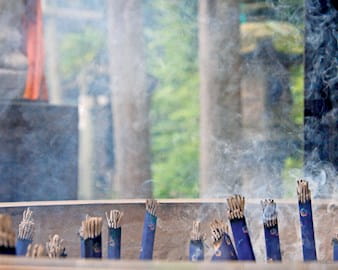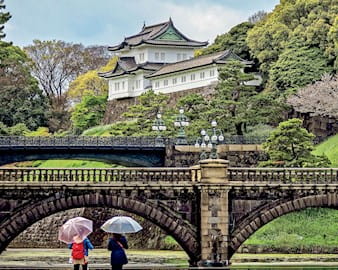
Alumni in this dazzling megacity are dedicated to boosting the next generation of Booth graduates from Japan.
- By
- October 10, 2017
- Global

No matter your industry, the draw to live in Tokyo is readily apparent: ultramodern transport, a fast-paced yet family-friendly lifestyle, and so many great restaurants that residents can hardly agree on a top-10 list. Add in the active contemporary art scene, buzzing nightlife, and neighborhoods brimming with longstanding cultural traditions, and it’s clear why Tokyo’s population is nearing 14 million, and growing.
More than 500 Booth alumni live in Japan, many of whom call this modern-meets-traditional metropolis home. Almost 20 percent of Booth’s tight-knit alumni here work in the banking industry, with other contingents in general management, consulting, and marketing. Those that work in Tokyo are increasingly focused on connecting with prospective students.
The Tokyo Experts
John Ehara, ’78
Cofounder and Partner, Unison Capital
Hirokazu Morita, ’13
Founder, 3D Stylee
Mark Miller, ’87
Founder, M.Square Inc.
Akiko Nakajo, ’06 (AXP-5)
Director of YouTube Partnerships Japan, Google
Kyota Narimatsu, ’11 (AXP-10)
Principal and Copresident, Finsbury Japan
“In the last 12 months, there’s been a concerted effort on many of our parts to meet prospective students, and there’s been a significant increase in enrollment at Booth from Japan,” said John Ehara, ’78, cofounder and partner at Unison Capital, a private equity firm with operations in Japan, Korea, and Singapore. “We want to maintain this momentum.”
As the city, long known for finance and industry roles, opens its doors to countless venture capitalists and entrepreneurs, many alumni events are taking on an entrepreneurial focus. Several times a year, Booth’s Tokyo alumni host the Chief-J Chicago Innovation and Entrepreneurship Forum, which facilitates connections among graduates there. In July, 230 alumni attended the first-ever panel—which included Ehara and was moderated by Eric J. Gleacher Distinguished Service Professor of Accounting Douglas J. Skinner—on corporate governance and the place of private equity in Japan.
“Alumni now have thoughts of starting their own business, so we try to match up our events with their interests,” said Japan alumni club president Kyota Narimatsu, ’11 (AXP-10), a principal and copresident at strategic communications firm Finsbury Japan.
Entrepreneur Hirokazu Morita, ’13, is also on their call list. This fall, Morita, the founder of a virtual-reality software startup called 3D Stylee, is hosting a meeting to discuss his experiences pursuing entrepreneurship in Tokyo as a relatively new alumnus.
The idea is to integrate students into the local network well before they return to Tokyo as alumni. “Many [prospective students] are in finance and industry, but are interested in becoming entrepreneurs after graduation,” he said.
Others prefer socializing outside of larger events. Recently, Mark Miller, ’87, ran in Bloomberg’s Square Mile Run alongside six Booth alumni. “We want to do some activities that are not intellectual,” joked the alumnus, a former investment banker and founder of M.Square Inc., a health product exporter. Miller also attends a Third Thursday social that’s hosted jointly with Booth graduates and the University of Chicago alumni club in Tokyo’s Roppongi district.
Many of Tokyo’s Booth alumni are making time for one-on-one meetings as well. If a prospective student asks Akiko Nakajo, ’06 (AXP-5), for coffee, the director of YouTube Partnerships Japan at Google makes room in her jam-packed schedule. Nakajo recently hosted a “ladies lunch” in Tokyo’s luxury Ginza neighborhood with Booth alumnae from Japan and Taiwan. Another women-focused event for alums of Booth, Wharton, and Harvard business schools was hosted at Google’s Japan office, as a way to connect with female MBAs and ramp up future female enrollment. “We are working with different alumni groups to encourage Japanese women to apply,” she said.
The Traditional Tavern: Ebisu Yokocho
Expect a constant crowd at Ebisu Yokocho, a series of tiny aka-chochin taverns on the ground floor of a building in the fashionable Shibuya neighborhood. Many of the food counters have different specialties—think yakitori (skewered chicken), okonomiyaki (grilled, savory pancakes), and other snacks. It’s become an informal after-work gathering place: diners navigate the food-alley-type setup to try a few of the offerings, said Morita, who works nearby. “It has a charming Japanese cultural style,” he added.

The Free Afternoon: Zeniarai Benten Shrine
The Shinto shrine, built circa 1185 inside a cave, is about an hour outside of Tokyo by train. Those who stop in to the candlelit shrine can spend part of the afternoon washing paper money or coins with the spring water inside the cave, a custom that is said to bring prosperity. (The washed money then needs to be spent in order to double in value.) The tradition isn’t always closely followed. “I even washed a credit card once,” recalled Nakajo. Visitors to the shrine can also spend time hiking in the nearby areas.
The Private Meeting: Tokyo Shiba Tofuya Ukai
Right next to the Tokyo Tower, Ukai (specializing in all things tofu) is a draw for visitors eager to see the site. The private rooms make it a good place to take clients for one-on-one meetings with lovely views out onto an elaborate Edo-style garden with a koi pond. Meals are served prix fixe style. “This is a really nice entertainment-type restaurant,” said Miller, who has dined there for business.

The Morning Run: Imperial Palace Jog
Ask locals and they will likely tell you that Tokyo’s most scenic jogging route is a loop around the Imperial Palace, which is slightly longer than a 5K run. The quintessential jogging destination doesn’t involve any street crossings and has plenty of drinking stations and a runners’ station where joggers can shower or rent sports gear. Sights of the palace itself, the Tokyo Tower, and the National Diet Building provide a stunning backdrop to break a sweat. “If you have time, this is the best place for a jog,” said Narimatsu.
The Out-of-Towner Dinner: Honmura An
The 46-seat spot in the Roppongi district has a tasting menu, exquisite service, and dishes unique enough to impress guests, said Nakajo. “During the cherry blossom season, they often put the leaves into the soba noodles, which brings out a really beautiful flavor,” added Nakajo, who used to visit the owner’s previous restaurant in New York.
The One-of-a-Kind Meal: Narisawa
Whether it’s serving up lunch or dinner, the creative Japanese hotspot with French influences is a crowd-pleaser for travelers and locals alike, said Ehara. Once you’ve scored a reservation, be prepared to spend a few hours enjoying the meal at this two-Michelin-starred restaurant. The menu showcases Japanese ingredients through what chef Yoshihiro Narisawa called “innovative Satoyama” cuisine, which is inspired by a part of Japan that’s surrounded by the sea and forests.
—By Alina Dizik

Executive MBA student Edoardo Collevecchio used Booth’s global flexibility to expand his company into Asia.
A Career Catalyst
Greg Hodge, ’16 (EXP-21), shared how leaders across industries can push past “wellness washing” and light the way toward meaningful change.
Lighting the Way toward Employee Well-Being
A close-knit alumni network supports its newest members as they settle into life in Mumbai.
The View From Mumbai